One of the most common reasons people give for not starting a garden is that they can’t afford it. They think about buying seeds or plants, soil amendments, tomato cages and all those tools they might need. Gardening certainly can be an expensive endeavor, but it doesn’t have to be.
If you want to grow your own food without spending an arm and leg on supplies there are many gardening supplies you can get very cheaply or even for free.
This site contains affiliate links. If you make a purchase using one of these links, I may earn a commission. Please see my disclosure page for more information about cookies collected and our privacy policy.
It takes some time to search out some of these alternative and it might take more advance planning, but if you want your garden to save you even more money give some of my suggestions a try and see how free gardening can be!
9 Gardening Supplies You Can Get for Free
1. Mulch
When it comes to gardening mulching is a very important step. It will keep the weeds down, conserve water and helps protect the soil from eroding. Mulching, if done in the fall, can also help prevent the need for tilling the soil. There are many different items you can use for mulch- and most of them are free.
Use grass clippings from your summer mowing. Ask your neighbors to share if they bag their clippings as well.
Newspaper is a wonderful weed block and mulch. Ask around at stores that have newspapers to see if you can have yesterday’s leftover papers or round up old papers from your neighborhood or office.
Many tree services are looking for a place to unload wood chips. Call around to different Tree Service Companies and see if you can get on a list. Many will even deliver them to you for free if they are chipping in your area.
Fall leaves can be saved to use for mulch in the summer or used for a fall mulch. If your neighbors or friends rake and bag their leaves ask if you can take them off their hands.
Don’t forget to check out your local Freecycle or Craigslist!
Related Reading: 8 Ways to Improve Your Soil for Free
2. Compost
Compost is in the same category as mulch. Most soils are lacking in nutrients these days, so if you want your garden to succeed you are going to have to amend the soil in some way. Here are a few ways to get some free compost for your garden.
Make your own! You can do this a couple ways. You can start a compost pile in your backyard. You can dig holes directly in your garden area and dump the days compost in and cover it up. You can make a worm-composter to keep under the sink. But however you do it, be sure you aren’t throwing out all those food scraps that can be so valuable for your garden!
Chopped leaves are a great source of nutrients as well. Use the same ideas I shared above to find a free source of leaves.
Use Freecycle, Craigslist or call around to some local farms to find used hay from barn bedding or manure from animals. Many times if you come and load the manure yourself you can get it for free.
3. Seeds
You can’t have a garden without seeds! This can be a major expense, especially if you want special varieties but if you plan smart and think ahead you can get many of the seeds you need for little or no money.
Join a seed exchange. Even if you don’t have seeds to share this year you can join in with the promise of saving seeds from this year’s produce and share them the following season.
Save seeds from the organic produce you already buy. You can save seeds from most anything you buy from the grocery store- melons, squash, tomatoes, peppers, cucumbers. The key here is to make sure it’s organic produce since the conventionally grown will most likely not produce a product you want, if they produce at all.
Get a hold of last years seeds. Most stores that sell seeds will only sell the current years seeds. If you have a source, or ask nicely, you might be able to get your hands on seeds marked for last year after they’ve been pulled from the shelves but before they’ve been thrown out.
4. Plant Starts
Many things can be hard to start from seed, especially for a beginning gardener. But here are a couple of ways you might be able to get some already started plants for free.
Just like the seeds, stores tend to throw out plants when they are starting to look a bit old and wilted. We’ve been at our local Farmer’s Co-op when the plant rep. was restocking the seedlings and managed to get about 50 sweet potato seedlings and 50 zucchini plants completely for free. They weren’t at their healthiest but they pepped up just fine once they got in the ground.
Barter with your gardening friends. If you have a friend who starts their own seeds see if they would be willing to make a deal with you- offer up a service from you in exchange for the started plants.
Here again you can use your organic store bought food as plant starts- regrow onions from the cut off root tips or plant the ends of your celery. You can re-grow potatoes from the older potatoes with eyes or sprout your sweet potato in water and pinch of the slips to grow.
Check out my Yearly Garden Planner to help you keep track of everything in your garden- from seed inventory to pests and disease. Keeping good records is the key to successful gardening year after year!
5. Plant Cuttings
Certain plants are very easy to propagate by taking cuttings off of a parent plant. Plants such as blackberries and raspberries put up new shoots and suckers from their roots that are easily transplanted. Strawberries put off runners each year which will root and can be moved to a new location. Many perennial herbs such as rosemary will root in water. So how can you get some of these plants for free?
Ask your neighbors and friends who garden. Sometimes a berry patch can get overrun with suckers and shoots. See if you can dig some up for yourself.
Use the wild plants around you. If you have a patch of wild blackberries or wineberries in your yard, dig up shoots and propagate more in your garden. Just be sure that you have permission to take cuttings before you do, if they aren’t in you own yard.
You can even take suckers off of tomato plants and root them in moist soil. They will grow in to new, fruit bearing plants.
6. Seed starting containers
There are many options when it comes to starting your seeds, and it can get expensive if you are buying peat pellets, peat pots or other containers in which to grow your seeds. But if you want it for free, use what you already have!
Use your recyclables! Yogurt cups and containers make great planters, as do milk cartons or cut-off jugs. You can poke a few holes in the bottoms to help with drainage and then just fill with soil and plant your seeds! You can also use egg cartons or clementine orange boxes filled with soil.
Make seed starting pots using recycled newspaper.
See my post on 20 Frugal Re-purposed Seed Starting Containers for more ideas.
Don’t forget to check your local Freecycle or Craigslist for people who no longer need their pots and planters!
7. Bamboo
Bamboo is very useful in the garden and can be used for staking tomatoes, vertically growing cucumbers or peas, or to make a fun tipi or tunnel of pole beans. It’s grown all over and if you look, you can probably go and cut some for free! Again, check out Freecycle or Craigslist. Bamboo plots tend to outgrow their desired space and often you can find people who just want to get rid of the stuff, especially if you come and cut it!
Make your homestead dreams come true! The Homestead Goal Planner will help you prioritize your life and your homestead goals and keep you on track with good planning practices. After all, goal with out a plan is just a dream!
8. Pallets
Similar to bamboo, recycled wooden pallets can be a wonderful resource to your garden. You can make fences, a compost bin, or a trellis out of them. You can even fill them with soil for a vertical wall of herbs or greens. Where can you get them?
Check your local feed store. They get pallets full of feed, seed and fertilizers everyday and usually have no use for the pallet once it’s used
Do you have a local brewery? They are also known to have many extra pallets to share
Keep your eyes opened when driving around town. Many places will leave pallets out back by the dumpsters or on the side of the road for pick up
And I’ve said it before, check Craigslist, Freecycle or even Facebook Marketplace!
9. Tools
Tools are probably thought of to be the biggest expense in gardening. A tiller, shovels, trowels, hoes, rakes. There is so much you need. But guess what? You don’t really need all of that stuff!
If you plan ahead and mulch heavily with newspaper, compost and other green materials such as clippings or leaves, the grass and weeds should be dead by planting time the following spring. You can plant directly into your composting mulch without tilling at all. This is also much better for the soil!
If you have mulched you also will not need as many tools for upkeep since you won’t have as many weeds
Use your most useful tool- your hands! Use your hands to part the soil to drop the seeds in and pull up those weeds using good old fashioned muscle power!
Use what you already have. I spent many years planting with a spoon from my kitchen. It worked just as well as a little hand shovel.
If you find there is a tool you really need try and borrow it from a friend or neighbor. Barter for the use of a tiller.
And one last time, use the free stuff offered by others on Freecycle or Craigslist. Post what you need and someone might have one they no longer need hanging around!
So there you go. If you follow all of my suggestions you can get almost 100% of your gardening supplies for free this year, which means all the food coming out of your garden will be free too! How do you cut costs when it comes to gardening?

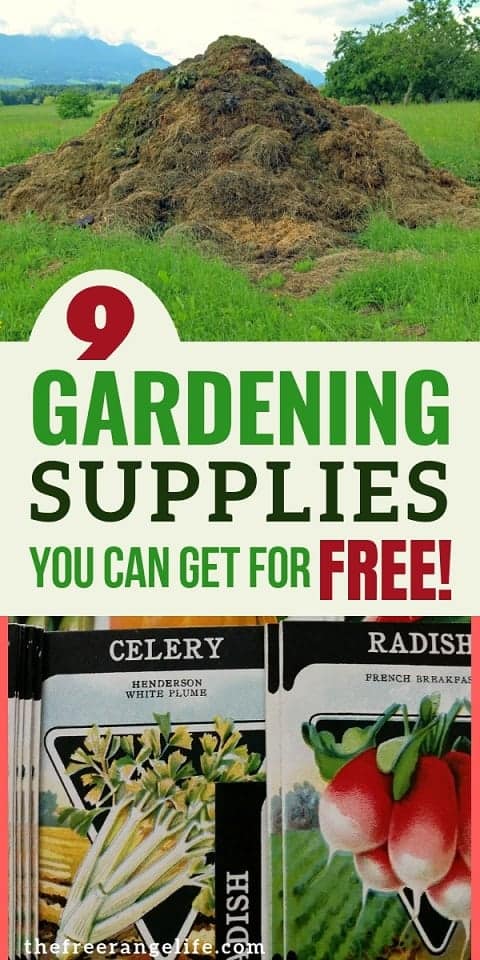
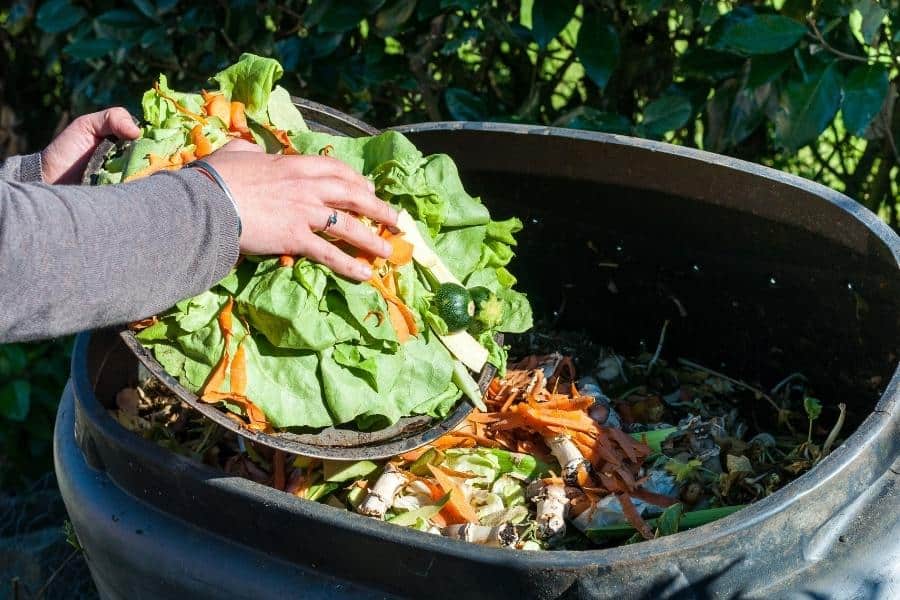
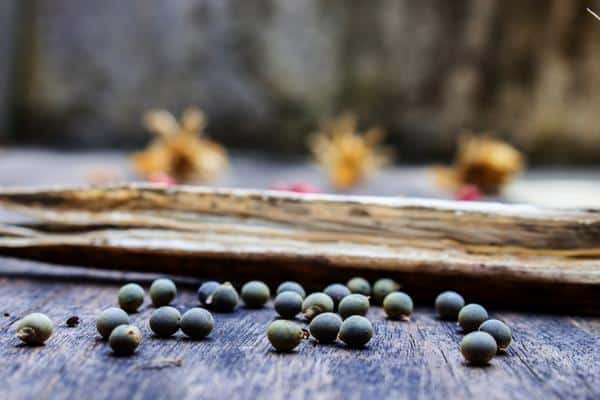
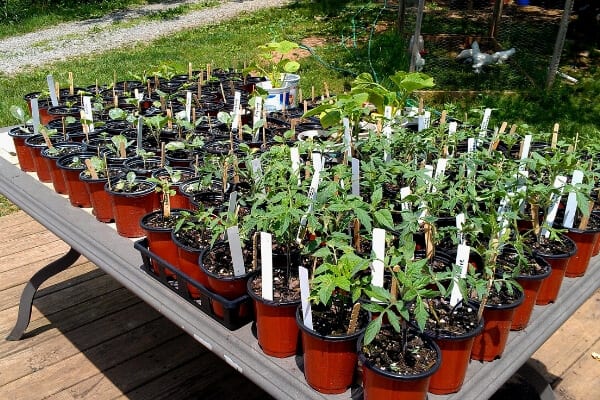
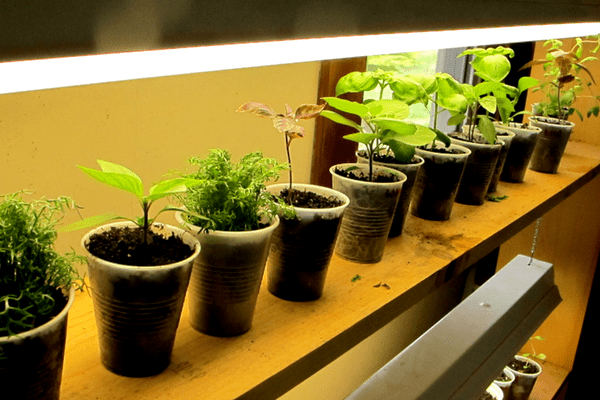
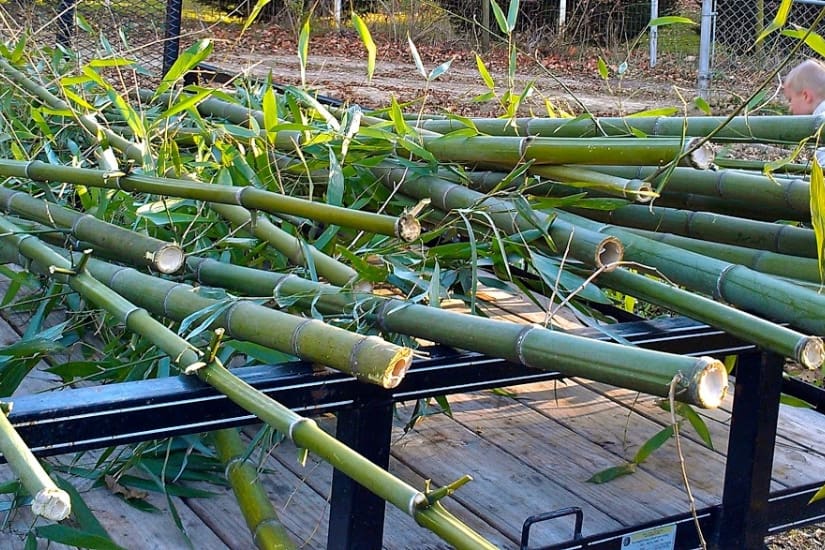
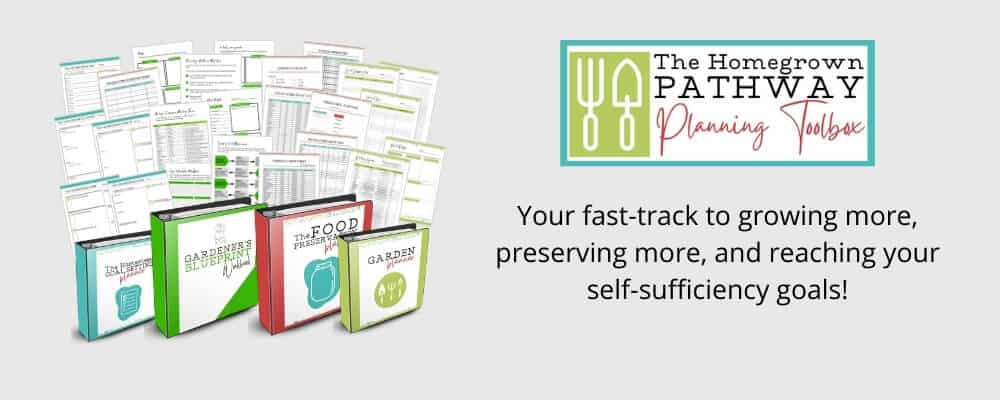
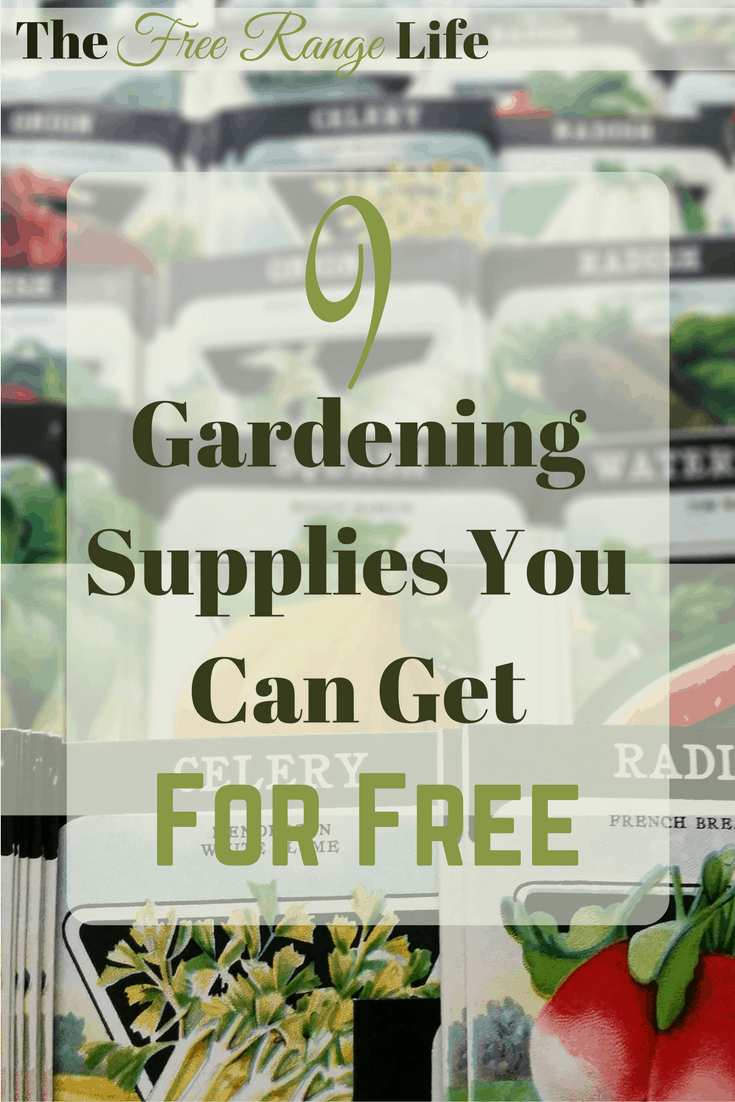
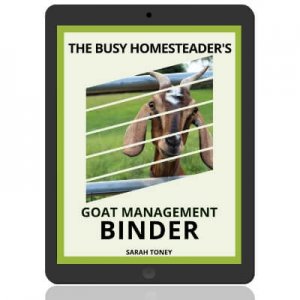
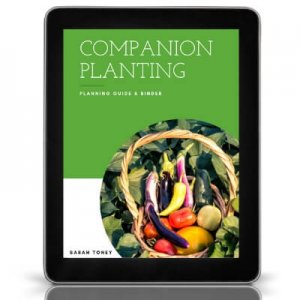
Totally agree with you! I only use my hand shovel and garden gloves on a regular bases. I get both for about a dollar at Dollorama. Some tools can be purchased at garage sales, too.
Such an interesting blog, Sarah, thank you! I only use egg shells to plant my vegetable seeds. It’s free and I do not have to worry about plastics, chemicals, etc. I save them for the year and in April I have all I need. I do boil them for a short time and put a hole in the bottom but then they are ready to go. Also, an excellent source of nitrogen.
Love this post! Only be very careful about #7, bamboo can show up on the wrong side of the neighbors fence on the opposite side of the yard from where you planted it! As for tools, I have one more suggestion, if you use the plastic milk jugs, then when the milk is gone, rinse it out and cut out a shovel opposite from the handle. I do that and get way more done than those tiny shovels you spend $10 for in the store! LOL
Angel
Great suggestion about the shovel! With the bamboo, I mean just to cut the stalks and use them for staking and supporting plants, not actually planting it. It can get everywhere! Which is why it’s easy to get for free!
Do you mean Japanese knot-weed sticks?
That’s what we have here that everyone calls bamboo…
No, real bamboo. Or a certain kind of it. I have a post on my personal blog about our trip to cut the bamboo. I’ve never heard of Japanese Knotweed sticks…
Please, please, please stay clear of Japanese knotweed. I live in the UK and it was introduced a couple of hundred years ago. It will grow everywhere and outcompete all other plants, it is a total nuisance. The Environment Agency in the UK has a page about it (link below) and if you see it you are supposed to report it to them so they can get rid of it.
http://www.environment-agency.gov.uk/homeandleisure/wildlife/130079.aspx
The knotweed is crazy invasive and takes an axe to cut the bases… it attracts Japanese beetles and they eat absolutely everything in sight. They can mow down a $1200 garden in a week. It seems impossible to get rid of and it’s all over Quebec, Vermont, and Maine… out-grows everything.
Wow! Glad we don’t have that around here!
You can prevent the roots of bamboo from spreading by planting it in a bed with a wall of flashing buried about 6-7 inches deep. This will keep the roots contained and make controlling it a lot easier than just planting it.
bamboo in the southern United States will take over everything My neighbor’s father planted 3 pots of the stuff 20 years ago and now she has 3 acres of the stuff and here in Alabama you need a trench 3 foot deep filled with concrete and maybe you have a chance to contain the stuff. I made the mistake of planting bamboo grass that was advertised not to spread but now it is all over my yard and spreading and replacing my lawn. Round up will not kill the stuff. Burning will not kill it either. So be careful what you plant. Happy Gardening
I know it can take over, that is why I mentioned it is easy to get for free and use (not plant) the canes in the garden for vertical growth of many vegetables. Thanks for your comment!
why don’t you get the local zoo to bring in a giant panda for a couple of days or have the zoo come in take it away after its been harvested , lots of animals eat it i.e. , elephants. yummy yummy.
Wow…one suggestion about using Cut, Non growing bamboo in your garden. Lol! How did such an Obvious and Clear suggestion get So misunderstood. Lol!
But just so You, Sarah, know. The suggestion was very clear.
In no way we’re you suggesting Planting the stuff. You Know it’s crazy invasive and hard to get rid of or control THAT is Exactly Why people might be Happy to have someone cut some down for them.🤣
Very Clear.
Thank you for the suggestion, it Is a good one👍
Great info! My only addition to this is make sure the packets you use have ‘HT’ stamped on them. it means heat treated. many others have been sorayed or infused with a chemical to prevent insect issues.
That is a wonderful recycle, repurpose suggestion!! Thank you!!
Love these suggestions!!! Thank you for sharing!!
How do you cut up the newspapers as mulch? In strips, shredded, pieces? I’ve heard of that before but have no idea how to do it. Thanks!
You want to use them as sheet mulch. Get few layers of newspaper wet and lay them down flat. You will have to have some sort of material to place on top to hold them down like grass, leaves or wood chips. By the time the newspaper decomposes the weeds will have been choked out.
I’ve used a wheel barrow with water in it, (parked up close to where you wish to place the newspaper for mulching), as it’s so much easier. cheers
Great subject, thank you for sharing these ideas!
Great list!
Great post…I knew all this but…didn’t! Nice to have it all in one place…thank you!! Sometimes the obvious isn’t so obvious.
Great post! Another excellent source of compost is someone’s pet rabbit, if its litterbox is filled with a biodegradable litter made from recycled paper or corncobs. Rabbit manure does not contain harmful bacteria (it’s almost sterile, because of rabbits’ unusual digestive process) and it quickly breaks down into great fertilizer.
My brother mulched his garden with ragweed! It helped keep this allergy-triggering plant under control, as well as nourishing his garden.
We use our own rabbit’s bedding in our garden all the time! Very interesting about the ragweed! Thanks for sharing!
Would it be safe to use the bedding from my guinea pig or hamster?
I don’t see why not. Vegetarian animals manure can be composted or turned into the garden just fine. It is also considered “cool” and can be used right away.
I haven’t ever mulched my garden. This year will be different. I will have to get the mulch done and ready for the Fall. Well after I get my Fall garden done. I’m going to be trying to get a PVC pipe greenhouse made and then I plan to make a PVC pipe trellis for my peas and green beans. My children are always buying me tools so I don’t have to buy anything tool wise for the garden.
Great list! Pinning now!
~L
Great list! Thank you.As a new gardener anything free is GREAT!
No matter who you are, free is always great!
Great advice/tips here. I’m going to need to remember this for next spring. Tweeting. :)
Worth the price… Nitrile gloves… thin, comfortable, good grip, indestructible.
I know some people need gloves. Personally I have tried, but I throw them off, I like the feel of the soil much better!
I’m with you Sadie I like the feel of the soil on my hands. Something very soothing about getting your hands in rich garden soil.
I feel the same! There is something about getting your hands in the soil. Something natural that I just love.
However, I’m concerned at the same time. I’m a vet tech and know this is a good way to pick up microscopic parasites that crawl through the skin. Parasites that will produce diarrhea in your canine bc they live in their digestive tracts. But with humans, apparently they live in weird places in our bodies. This freaks me out a little, how do you know if you pick up a parasite like that? For this reason I buy gloves and think this time I’ll wear them. But that never lasts. Does anyone else ever worry about parasites or protozoan’s? If so what do you do? I hope I didn’t just ruin it for anyone. But this is a concern, is it a silly one? I’m not worried about what I can see, it’s what I cannot see.
I don’t garden but these sound like some wonderful tips! You posted a plethora of information here, I’m going to pass this along to my gardening friends =)
If you have a plant that’s a heavy calcium feeder, you can start it in a washed out egg shell. When it comes time to plant, you just crack the shell around the roots and plant the whole thing.
Great post! Very informative! Thanks for sharing over at the Homeacre Hop! Please join us again soon!
Mary :)
Wonderful, informative gardening tips – we have a pile of ground tree, but I was hesitant to use as mulch. I’d heard that it uses a lot of nitrogen to break down – we have a lot of bamboo in our area – wonderful garden tools! I am delighted that you shared with Home and Garden Thursday,
Kathy
It will steal nitrogen from the soil if it is dug in, but not as a mulch. So be sure to move it aside to plant seeds and push back in place as they grow. Thanks for stopping by!
Love your ideas. Also, plant stores are always throwing out pots. So if need huge ones for potatoes, etc, you can get them for free.
As for pallet gardening, I would be concerned about using them for food plants since the pallets could have some nasty chemicals in them.
Look for the letters HT on your pallets. That means they have been heat treated rather than chemically treated and can be used in the garden.
That’s right! I forgot about that. Thank you for the HT(Heat Treated) reminder 👍!
Great information. Does anyone know where to go for free gardening decorative brick type stuff to put around trees, etc
Very helpful post – thanks for sharing with our readers.
You just got featured so please do come and grab your button. This was such a detailed post, I know it will be really useful for many gardeners and frugal living fans.
Great helpful post! Thanks for all of the information.
Awesome tips. Followed you from the Homestead Barn Hop.
Love for you to come by Wildcrafting Wednesday and share.
These are some great tips! I miss having a big yard with a garden and compose. I do mulch my flower beds and small garden area. It really does help. My husband tries every year to buy bagged mulch but I won’t let him. It’s so much better to save your own leaves and grass clipping. Thanks for sharing your wonderful tips.
Great list Thanks I safe the plastic containers from cookies and such from the Bakery& deli of my groc. store They make great little hot houses . Cut the bottom off a 2 liter bottle and you have a waterpan and a top the to keep the moisture in w/your starts
Absolutely love all these tips, ideas and suggestions! Thanks everyone!
What a great list of ideas! We’re always looking for ways to cut costs so loved all these ideas
Our city recycling department can’t handle shredded paper. And we accumulate a lot at our house. I’ve used a little at a time in our compost pile, but I’m thinking that I might use it in the garden come spring. Anybody have any thoughts or experience on this?
Lookup lasanga gardening. Uses paper or cardboard, leaves, cutting. Whatever. No weeds and no digging.
You can save TP or paper towel tubes to start seeds in. I am flattening my tubes as I plan to square them up to conserve space, starting my plants in bakery box greenhouses with old aquarium gravel under the upright tubes full of dirt. You can plant the moist, decomposing cardboard tubes, splitting if needed. You can cover a garden with black yard bags to kill weeds, too. Then you put them away to reuse.
You may want to check on newspaper, most has soy based ink now, which is from GMO soy…..may not be the best for the garden. If it is not soy based, then it is usually petroleum based, which could also pose risks for garden contamination. We use eggshells to plant seedlings in often, then transplant right in the shell, cracking the bottom to let roots grow through.
I would expect the decomposition process to break all those proteins downs. By the time the GMO soy is refined to the point of becoming ink, and then broken down further with decomposition, I wouldn’t expect a problem. Even GMOs are carbon-based organisms which are going to break down.
Around my city we have lots of trees being cut down and mulched because of emerald ash borer bug infestation….my question is can this mulch be used on gardens or not?
I am not sure of the likeliness of transporting the borer through the woodchips. My gut would tell me to steer clear, especially if you have an infestation in your area.
Wood chips are problematic as mulch, robbing the soil of nitrogen, attracting termites, spreading ash borers or other pests. Leaves should be shredded first. Manure should be aged before being used in the garden. Wineberries are exotic invasives that disrupt the ecosystem. Bamboo is even worse.
cheers
Yes leaves should be shredded and manure aged- though I use alpaca and rabbit manures fresh with no problems. Woodchips don’t rob nitrogen when used as mulch, only if they are dug in. We have winberries growing wild around here, along with wild blackberries- sure they can get out of control but if we cultivate them carefully we can control their growth. I have heard lots of people say that cut bamboo will re-root, but I have never had issue with my bamboo that I have cut from others’ growing patches and allowed to cure and dry before using in the garden. I never leave it in year round and remove and store it after each use. Thanks for reading and commenting!
A friend of mine has a property that is taken over with bamboo, and I’ve already planned to get a bunch to build all kinds of things in my yard. I think it’s a good use of this invasive resource.
If we all started harvesting these invasive bamboo patches, and other plants that have already become invasive, then we might get the invasions under control.
There is a group of young people who are harvesting invasive Elaeagnus (autumn olive, autumnberry) in the midwest, using the delicious and nutrition-rich berries (rich in lycopene) to make products they can sell, and then using the branches of the shrub to build permaculture gardens. Guess what, those berries will not be spread by birds to reproduce further. What if everyone with invasive Eleagnus started doing this? Making their own pies and sauces and jams and repurposing the wood? http://www.autumnberryinspired.com
Here in the South, Japanese honeysuckle has taken over. It’s delightful smelling and beautiful but horribly, horribly invasive and smothers out native vegetation. However, this Lonicera japonica is also used in Asian medicine to help with cold and flu viruses. Scientists are finding out that it does, in fact, have a compound that suppresses flu viruses: http://www.sci-news.com/medicine/science-virological-penicillin-honeysuckle-02206.html
I am also planning to learn how to use the tough honeysuckle vines as binders.
Kudzu, bamboo, honeysuckle…if we all got out there are made right use of these resources, we would control the invasiveness. As my husband and I head into retirement, we are looking to learn more about how to do these things.
For chipped mulch, you might try https://www.chipero.com/ to have it delivered to you.
Anna, you are 100% Right!! And I love you for telling it 😃!
wonderful ideas and tips, except for one HUGE issue. you say organic produce can be used to save the seeds to plant for yourself. this is misleading. organic methods of food production are often used on hybrid seeds. if you save seed from a hybrid, you have no idea what quality of plant and produce you will get out of it. the only way to be sure you will get what you want is to plant from open pollinated or heirloom fruits and vegetables. organic is best, hybrids are to be avoided.
Pallets are not a good idea at all.Most are treated with chemicals to prevent rotting. Many will have paint on them as id marks for their original users. In many cities tree mulch is generated from park trees or Christmas trees, all of which have had chemicals applied to them at some point.Don’t use if you wish to be organic.
I have other sources telling me that the pallets they use are usually untreated lumber. I would love to find out how to discover this definitively.
Marvelous article! Some of the things I already do are getting coffee grounds, eggshells and hair clippings from closeby neighbors to nourish the garden soil. I use newspapers to stop weeds, and I save toilet paper rolls all year to use as seedling cups in spring. I also trade seed and rootlings with a neighbor who gardens. Can’t wait to get a look see a craigs.list and see the freebies there!
These are the same practices I use in my garden. I make my own mulch, compost. I save seeds from my produce. I find free pots to use for starter containers. Actually I have had many blog posts on how to garden for free @
Do you have a link to your blog posts? I would love to check them out.
I use coffee grounds for my flower and rose plants . Would it also be good for the vegetable garden ?
I got a free dumptruck size pile of mulch from my electric company because they cut down the trees and branches near wires. The only problem is that it wasn’t clean. It was whatever was cut down and not sorted by plant. We have a problem with poison ivy in my area. In the spring, I posted on Freshare that I wanted plants in any form. I got houseplants that were divided, perenials that were divided, selfseeding annuals that were divided, old packets of seeds, and seeds that were saved from plants. I don’t drive so I asked a friend to take me to pick up some of the stuff. Each person gave us enough stuff for both of us. Then, this friend divided the Irises in her father’s yard and gave me some of them. I went to a free lecture that the local cooperitive extension gave at the library about gardening. Each person that attended, received a coupon for a free compost bin.
I always buy my seeds at the tail end of the growing season in MN at steep discounts for the following year, sometimes as low as 25 cents for seeds that nearly cost $2 normally and they always work great!
You can also use kuric cups as pots
Hello, I am getting the coffee grounds from Starbucks to add to my garden. Is this a good idea? Does anyone else use it? Thanks!!
Absolutely! Coffee grounds, tea bags, and eggshells are my favorite fertilizers.
My family was wondering if anyone can help us repair my dad’s gardening tools because there was a fire in our shed and his tools were in there and they got burnt and no longer work. Please call (714) 277-0519. Thank you for reading this comment.
Several good tips here. But a clarification on growing seeds from produce you get at the store (or farmer’s market, or CSA, or roadside stand), It isn’t ORGANIC you are looking for, but non-hybridized or open-pollinated varieties, also referred to as heirloom. I can grow a hybrid (this is not GMO, but a cross between 2 parent varieties that produces a know quantity third variety of seeds) tomato plant organically and those tomatoes are organic. But you don’t want their seeds as they will not grow a new plant with exactly the same qualities as the parent plant. Or maybe you do want to grow some to see what comes up — just don’t expect it to be identical to the (organic hybrid) tomato you bought.
True that it may not produce true to it’s parent, but my organic qualification was in respect to the fact that many conventionally grown produce is chemically treated and the seeds will not germinate or grow at all.
Yes I agree that the money aspect of gardening does put a lot of people off. I think I can save some cash by following this advice. I am known for wasting money unnecessarily. I love the shovel and bamboo tip.
Nice article! thanks for sharing this excellent information.
I don’t gat the answer wear to get the free compost bot I In joint the article
You’re right. I saw some people who are very lazy and they feel very attractive with their laziness! I talk with some people and they share me a there story but that’s very funny do you know! haha they said that they have the wish of gardening but every day he has to wake and they have to give water, and another kind of supplements so It’s the reason they hate gardening, haha but I took it very funny!
Remember that egg shell make great pots for growing seedlings and then can be planted directly into the soil for additional nitrogen.
Such an informative post, totally new to all of this. Thanks for sharing!
I can’t wait to try some of these ideas
Empty toilet paper rolls work well for starting seeds.
Wonderful article, wonderful comments.
I’m surprised no one mentioned wood ashes, which are high in potassium and calcium, and in small amounts make an excellent amendment, (unless you have alkaline soil when you should not use it). I add about 1-2 cups of ashes per 5 gallon bucket of compost before spreading it on the garden, or about a shovel-full per wheelbarrow of compost.
I’ve also used pine needles as mulch, but only around plants that like acidity, such as blueberry bushes! Coffee grounds dumped directly around their soil would probably also make blueberry bushes happy, otherwise I compost the coffee grounds before adding to a regular vegetable patch.
Also, thinking sideways, there are many things you can do to understand your soil that are free, like a basic acidity test, examining the soil for organic matter, testing for amounts of clay, sand, and loam. Also analyzing your leaves for nutritional clues. Understanding what your soil needs saves a lot of money and gets better results and a lot more produce.
One last thing – no one mentioned collecting or reusing water on the garden. I was able to get a 55 gallon rain barrel for free through a workshop offered by a local water treatment plant. They reused the barrels of their water amendments, gave us a tap, and showed us how to cut and make our own with them there to guide us. Water is a very large expense to gardening, so saving rainwater is very helpful.
And you might check to see if your city’s waste department has incentives for composting. My city offers a full refund on any compost bin purchased, so you can get a compost bin for free.
BoxGiver is also a great resource
Snap allows you to buy vegetable seeds with your stamps. Only vegetable seeds.
Be careful about manure from cattle and horses. If the animals grazed in areas where Grazon has been used, the chemical will pass through the animal and kill your plants – all of them! If the animal owners have fed their livestock with hay, they might not know if the hay holds Grazon.
Also, manure must be composted for at least a year so it won’t burn your plants
Great list. Also, many local public libraries may have tools to lend and/or a seed exchange all for FREE! If your doesn’t see about starting a seed exchange or tool share.